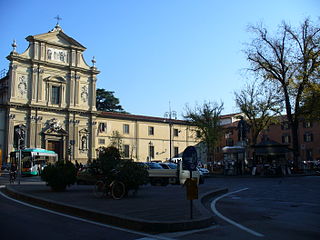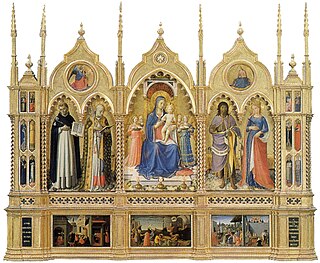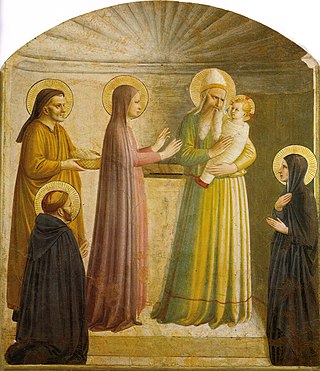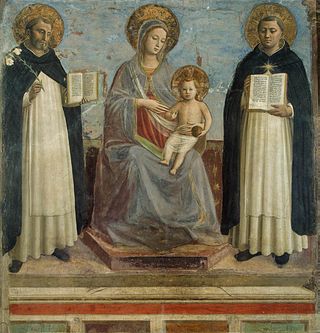
Fra Angelico, OP was a Dominican friar and Italian painter of the Early Renaissance, described by Giorgio Vasari in his Lives of the Artists as having "a rare and perfect talent". He earned his reputation primarily for the series of frescoes he made for his own friary, San Marco, in Florence, then worked in Rome and other cities. All his known work is of religious subjects.

The Badìa Fiorentina is an abbey and church now home to the Monastic Communities of Jerusalem situated on the Via del Proconsolo in the centre of Florence, Italy. Dante supposedly grew up across the street in what is now called the 'Casa di Dante', rebuilt in 1910 as a museum to Dante. He would have heard the monks singing the Mass and the Offices here in Latin Gregorian chant, as he famously recounts in his Commedia: "Florence, within her ancient walls embraced, Whence nones and terce still ring to all the town, Abode aforetime, peaceful, temperate, chaste." In 1373, Boccaccio delivered his famous lectures on Dante's Divine Comedy in the subsidiary chapel of Santo Stefano, just next to the north entrance of the Badia's church.

Benozzo Gozzoli was an Italian Renaissance painter from Florence. A pupil of Fra Angelico, Gozzoli is best known for a series of murals in the Magi Chapel of the Palazzo Medici-Riccardi, depicting festive, vibrant processions with fine attention to detail and a pronounced International Gothic influence. The chapel's fresco cycle reveals a new Renaissance interest in nature with its realistic depiction of landscapes and vivid human portraits. Gozzoli is considered one of the most prolific fresco painters of his generation. While he was mainly active in Tuscany, he also worked in Umbria and Rome.

Museo Nazionale di San Marco is an art museum housed in the monumental section of the medieval Dominican convent of San Marco dedicated to St Mark, situated on the present-day Piazza San Marco, in Florence, a region of Tuscany, Italy.
The decade of the 1430s in art involved some significant events.

The Prado Annunciation is an altarpiece painted by the Italian Renaissance painter Giovanni da Fiesole, known as Fra Angelico, in the 1420s. It is one of his best-known works. Originally destined for the convent of the observant Dominicans of Fiesole, the painting is currently in the collection of the Museo del Prado in Madrid. It is one of three altarpieces by Fra Angelico representing the Annunciation; the other two being the Cortona Annunciation and the Annunciation of San Giovanni Valdarno. The sequence in which the three works were painted is not certain, but the general art historical consensus places the Prado version first.

The Coronation of the Virgin is a painting of the Coronation of the Virgin by the Italian early Renaissance painter Fra Angelico, executed around 1432. It is now in the Uffizi Gallery of Florence. The artist executed another Coronation of the Virgin, now in the Louvre in Paris.

The Coronation of the Virgin is a painting by the Italian early Renaissance master Fra Angelico, executed around 1434–1435 in Fiesole (Florence). It is now in the Musée du Louvre of Paris, France. The artist executed another Coronation of the Virgin, now in the Uffizi in Florence.

The Perugia Altarpiece is a painting by the Italian early Renaissance painter Fra Angelico, housed in the Galleria Nazionale dell'Umbria of Perugia, Italy.

The St. Peter of Verona Triptych is a tempera-on-panel painting by the Italian early Renaissance master Fra Angelico, executed around 1428–1429. It is housed in the National Museum of San Marco in Florence, Italy.

The Galleria nazionale di Parma is an art gallery in Parma, northern Italy.

Zanobi di Benedetto di Caroccio degli Strozzi, normally referred to more simply as Zanobi Strozzi, was an Italian Renaissance painter and manuscript illuminator active in Florence and nearby Fiesole. He was closely associated with Fra Angelico, probably as his pupil, as told by Vasari. He is the same painter as the Master of the Buckingham Palace Madonna. Most of his surviving works are manuscript illuminations but a number of panel paintings have also been attributed to him, including seven altarpieces and six panels with the Virgin and Child, along with some designs for metalwork.

Presentazione di Gesù al Tempio is a fresco by Fra Angelico made for the then Dominican Convent of Saint Mark in Florence, Italy. It depicts the dedication of Jesus in the Temple in Jerusalem as the first-born son of His family, as related in the Gospel of St. Luke, 2:23–24. Saint Joseph carries a basket containing two doves as Mary witnesses the Infant Jesus being held by Simeon. This event, the fourth Joyful Mystery of the Rosary, a devotion particularly promoted by the Dominicans, is depicted as being anachronistically witnessed by the Dominican saints Peter of Verona and Catherine of Siena.

Madonna and Child is a c.1435 fresco fragment by the Italian Renaissance master Fra Angelico in the sacra conversazione style. It was originally painted in the dormitory of the Convent of San Domenico, Fiesole. It was removed from the wall after the convent's suppression during the Napoleonic occupation of Italy and is now in the Hermitage Museum in St Petersburg.

Crucifixion with Mourners and St Dominic is a fresco fragment by the Italian early Renaissance painter Fra Angelico, executed c. 1435, from the refectory of the Convent of San Domenico, Fiesole, now in the Louvre.

The Croce al Tempio Lamentation is a 1436 or 1440 tempera-on-panel painting by Fra Angelico, now in the Museo nazionale di San Marco in Florence. It is named after its commissioner, the 'Compagnia di Santa Maria della Croce al Tempio'.

The panels of the Armadio degli Argenti are a series of tempera paintings on panel created by Fra Angelico ca. 1451–1453 and completed later by other hands using his preparatory drawings. They are now in the Museo nazionale di San Marco in Florence.
Saint James and Saint Lucy Predella is a circa 1426 to 1428 series of five tempera on panel paintings by Beato Angelico. Together, and possibly with other unknown paintings, they formed the predella to a single altarpiece, now lost or not clearly identified. They are dated on the basis of stylistic motifs and they cannot be later than 1435, when Andrea di Giusto copied Naming in the predella of his own altarpiece now in the Museo civico in Prato.



















